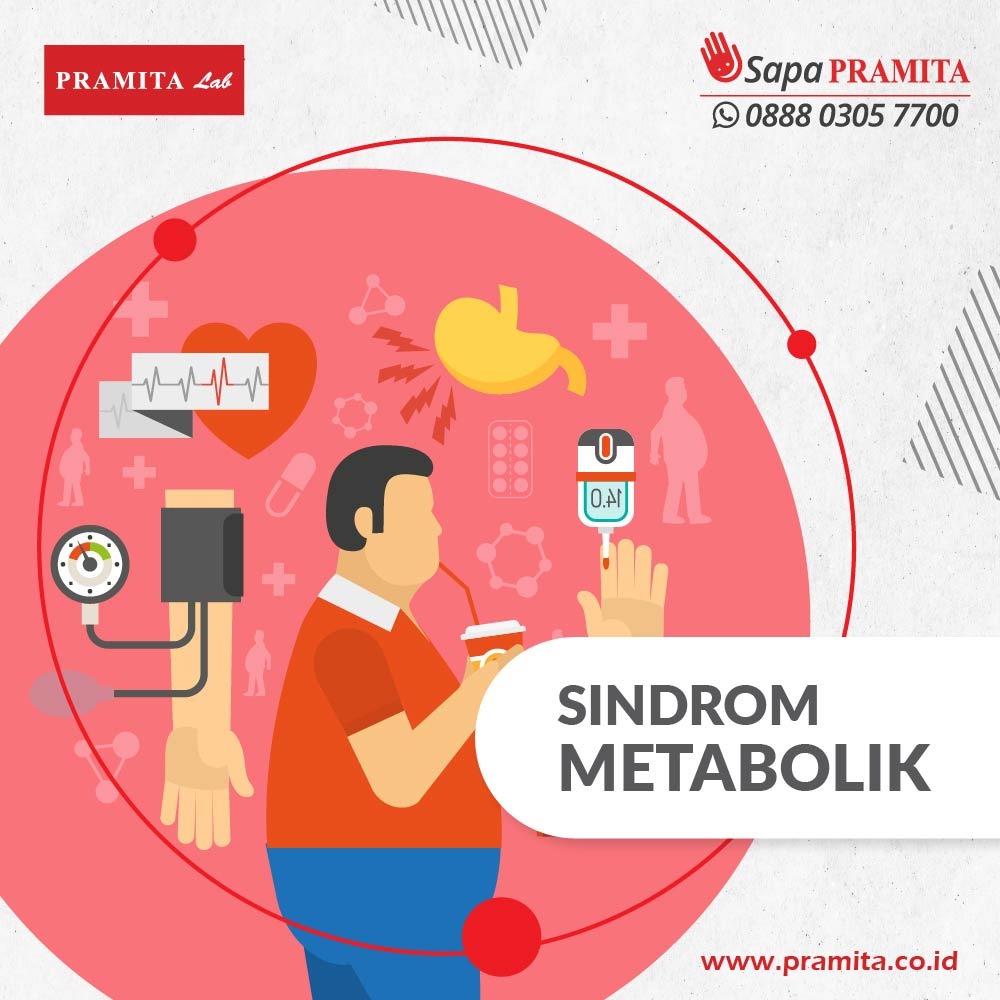Healthy Inspirations
Semua
Work Life
INFO PEMERIKSAAN
Parenting/Kesehatan Anak
LabPedia
Life Style
Kesehatan Wanita
Health Info
Millenial
Info Kesehatan
Mitos/Fakta

METABOLICAL SYNDROM
Tue, 15 Dec 2020
A. Introduction
Metabolical Syndrome (MS) is a collection of abnormal metabolic symptoms which include hypertension, central obesity,
insulin resistance, atherogenic dyslipidemia. Metabolic syndrome is strongly associated with an increased risk of cardiovascular disease. The World Health Organization (WHO) first introduced the definition of metabolic syndrome in the presence of insulin resistance coupled with 2 risk factors, namely: obesity, hyperlipidemia, hypertension, or microalbuminuria.
B. Signs and symptoms
1. Large stomach
2. Often feel thirsty
3. Inreased frequency of urination
4. Easily get tired
5. Headache
6. Soreness
7. Shortness of breath
C. Causes and risk factors
1. Unhealthy diet by eating too much fatty and sweet foods
2. Rarely or not exercising regularly
3. Smoking
4. Increasing age
5. Have a family member who suffers metabolical syndrome
D. Diagnosis
A person can be said to have metabolic syndrome, if they have at least 3 of the following 5 criteria:
1. Large waist, > 90 cm in men and > 80 cm in women
2. High density lipoprotein (HDL) or good cholesterol level are less than 50 mg / dl
3. Triglyceride levels in the blood >150 mg / dl
4. Consistent blood pressure of 140/90 or more
5. Fasting blood sugar levels of 100 mg / dl or higher
E. Treatment
The treatment given depends on the conditions and symptoms that appear in each patient or it is advisable to come to a specialist in internal medicine, especially an endocrine consultant.
Medicines that are often used are:
1. Diuretic drugs, beta blockers, or ACE inhibitor drugs to treat high blood pressure
2. Statin class drugs, for example atorvastatin, simvastatin to treat high cholesterol
3. Diabetes drugs, such as metformin
F. Systemic Effects of Metabolic Syndrome
1. Kidneys
Microalbuminuria, glomerulomegaly, focal segmental glomerulosclerosis, chronic renal failure
2. Liver
Increased serum Transaminase, nonalcoholic steatohepatitis (NASH), nonalcoholic fatty liver disease (NAFLD), hepatic fibrosis, cirrhosis
3. Skin
Acanthosis nigricans, lichen planus, systemic lupus erythematosus, psoriasis, androgenic alopecia, skin tags, skin cancer, and acne
4. Eyes
Nondiabetic retinopathy, central retinal artery occlusion, oculomotor nerve palsy
5. The reproductive system
Hypogonadism, polycystic ovarian syndrome (PCOS) and erectile dysfunction
6. Cardivascular system
Coronary heart disease (CHD), mycordial infarction (MI), and stroke
7. Cancer
Breast cancer, pancreatic cancer, prostate cancer
G. Prevention
1. Exercise light regularly, at least 30 minutes every day
2. Lose weight until you reach your ideal body weight
3. Consume foods high in fiber, such as fruits and vegetables
4. Limit your intake of salt, sugar, saturated fat and alcoholic beverages
5. Quit smoking
6. Manage stress well
Author: dr. Zulfikar Indra, M.Kes, Sp.PK (Doctor in Charge of PRAMITA Clinic Lab Branch Jl. Garuda No. 79 Ruko 4-5 Mahakeret Barat Manado).
Metabolical Syndrome (MS) is a collection of abnormal metabolic symptoms which include hypertension, central obesity,
insulin resistance, atherogenic dyslipidemia. Metabolic syndrome is strongly associated with an increased risk of cardiovascular disease. The World Health Organization (WHO) first introduced the definition of metabolic syndrome in the presence of insulin resistance coupled with 2 risk factors, namely: obesity, hyperlipidemia, hypertension, or microalbuminuria.
B. Signs and symptoms
1. Large stomach
2. Often feel thirsty
3. Inreased frequency of urination
4. Easily get tired
5. Headache
6. Soreness
7. Shortness of breath
C. Causes and risk factors
1. Unhealthy diet by eating too much fatty and sweet foods
2. Rarely or not exercising regularly
3. Smoking
4. Increasing age
5. Have a family member who suffers metabolical syndrome
D. Diagnosis
A person can be said to have metabolic syndrome, if they have at least 3 of the following 5 criteria:
1. Large waist, > 90 cm in men and > 80 cm in women
2. High density lipoprotein (HDL) or good cholesterol level are less than 50 mg / dl
3. Triglyceride levels in the blood >150 mg / dl
4. Consistent blood pressure of 140/90 or more
5. Fasting blood sugar levels of 100 mg / dl or higher
E. Treatment
The treatment given depends on the conditions and symptoms that appear in each patient or it is advisable to come to a specialist in internal medicine, especially an endocrine consultant.
Medicines that are often used are:
1. Diuretic drugs, beta blockers, or ACE inhibitor drugs to treat high blood pressure
2. Statin class drugs, for example atorvastatin, simvastatin to treat high cholesterol
3. Diabetes drugs, such as metformin
F. Systemic Effects of Metabolic Syndrome
1. Kidneys
Microalbuminuria, glomerulomegaly, focal segmental glomerulosclerosis, chronic renal failure
2. Liver
Increased serum Transaminase, nonalcoholic steatohepatitis (NASH), nonalcoholic fatty liver disease (NAFLD), hepatic fibrosis, cirrhosis
3. Skin
Acanthosis nigricans, lichen planus, systemic lupus erythematosus, psoriasis, androgenic alopecia, skin tags, skin cancer, and acne
4. Eyes
Nondiabetic retinopathy, central retinal artery occlusion, oculomotor nerve palsy
5. The reproductive system
Hypogonadism, polycystic ovarian syndrome (PCOS) and erectile dysfunction
6. Cardivascular system
Coronary heart disease (CHD), mycordial infarction (MI), and stroke
7. Cancer
Breast cancer, pancreatic cancer, prostate cancer
G. Prevention
1. Exercise light regularly, at least 30 minutes every day
2. Lose weight until you reach your ideal body weight
3. Consume foods high in fiber, such as fruits and vegetables
4. Limit your intake of salt, sugar, saturated fat and alcoholic beverages
5. Quit smoking
6. Manage stress well
Author: dr. Zulfikar Indra, M.Kes, Sp.PK (Doctor in Charge of PRAMITA Clinic Lab Branch Jl. Garuda No. 79 Ruko 4-5 Mahakeret Barat Manado).

